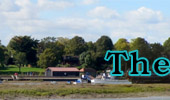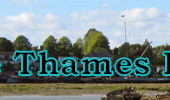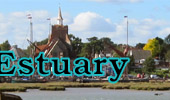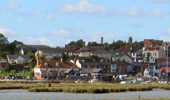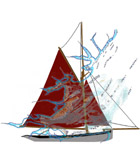
|

|
| estuary |
thamesestu |
thamesestu |
thamesestu |
thamesestu |
thamesestu |
thamesestu |
thamesestu |
thamesestu |
thamesestu |
estuary |
thamesestu |
thamesestu |
thamesestu |
thamesestu |
thamesestu |
thamesestu |
thamesestu |
thamesestu |
thamesestu |
thamesestuary |
| |
|
 |
The Channel Crossing |
|
|
| |
|

| Monday, August 9th 2010 |
|
|
| |
It is only normal to start the day of a Channel crossing at Blankenberge very early at 5.30 Belgian time. All three weather forecasts (BBC Coastal Forecast, Koenigliche Weather Forecast of the Netherlands and the German Shipping Weather) basically agreed on slight SW winds of 2 to 3 bf veering to W and to increase slightly. They forecast a clear, sunny day with practically no waves. The tide would not be running in my favour at first unfortunately, but since it would turn while crossing, I did not worry too much about it.
When I open the hatch, I can just make out the next boat for the thick fog which obscures everything more distant than 10 meters. I decide to get ready for a departure at 6.30, hoping the mist will clear sufficiently by then, wash and have breakfast. One hour later I can just make out the blue sky above the mist, but motor very slowly through the canal out of the harbour of Blankenberge. Although there is not a breath of wind stirring, I decide to hoist the main sail still close to the beach and by the time I motor westwards along the coast of Belgium, the fog has cleared completely.
Problems start at about nine o'clock, when a breeze from the SW is picking up, soon becoming a gusty wind of 3 to 4 bf and while blowing against the tide running westwards, it is whipping up a rather short and steep sea. By the time I reach the shipping lanes at midday, Betty sticks her bowsprit deep into every other wave and we make 2 to 3 knots at most. The trouble is, with the wind blowing from the direction it now is, I can no longer use the foresails to lift and stabilize the bow over the waves, which are getting higher the longer it is blowing. My only hope is the change of the tide in the afternoon, but now another problem manifests itself, the ship is making too much water. Only now it becomes clear, that the boat has dried out too much in the almost ten weeks in the shed and during that heat wave to boot. And the time back in the water has certainly not been long enough for the wood to expand completely and stop the gaps. Going through the waves instead of over them lets the water find its way through every seam in the deck and the cockpit and my electric bilge pump is simply overpowered. Now I have to man a pump and bail out the bilge manually every now and then. But apart from the slow speed we make and the discomfort of water sloshing from side to side down below, everything is hunky-dory.
But after crossing the traffic separation zone it gets really tough: Although the tide is now slowly turning in my favour and the wind decides to change to a more SW direction - which should be favourable and makes me hoist the foresails - it slowly picks up in force to a 5, occasionally 6 bf and the waves get higher and higher. I am now motor sailing, but soon the autopilot is overwhelmed and instead of steering the ship some of the time, I now have to man the tiller for good, making it impossible to be at the bilge pump at the same time.
So here I sit hour after hour, steering an over canvassed boat over cresting waves, outmaneuvering every other BIG one, that comes rolling in like a mountain with a crown of white foam, while a couple of bathtubs of salt water are sloshing back and forth inside the boat and I can't do the least thing about it... At about seven o'clock I start to get frightened: the wind seems to get even stronger and I definitely need to get some of the sails down, especially the big jib, which is now just too big for this wind. I still need to keep the staysail up to help the bow over the waves. Then again much later, finally past the huge offshore wind farm, using the autopilot to turn the boat and opening the main all the way as a shadow for the jib, I finally get it down and stowed away in the forepeak. Luckily without accidental gybe I manage to turn the boat around and resume playing hide and seek with the big rollers for a very long time. Until quite exhausted, I reach the shelter of the land, the waves are getting less frightening and after having put up the paraffin navigational lights as it is getting dark fast, I mange to take down the main and enter Ramsgate Harbour at 23.00, sixteen and a half hour after I set out from Blankenberge.
When tied up to the marina pontoon in the Royal Harbour, the wind is still howling in the rigging, but Betty is safe now and I can start taking stock of the damage. Well, luckily it is not as bad as I first thought. After wiping the floors and moving lots of stuff around, I even manage to find a dry bunk for tonight and apart from the mattresses drenched in sea water and most of my clothing soaking wet, there is no damage. So I settle down to have something quick to eat, thinking all the time: Thank God, I made it and the sleeping bag stayed dry!
This crossing, the last of a total of seven (four with Betty in 2003 and 2004, and two before that), turned out to be far too much on the brink for what I would consider safe - 'border lining' in other words. If only the slightest thing had gone wrong on top, I would have been in serious trouble and this is not a good realisation on a trip you are single handing. The most obvious conclusion: I can not have complete trust in any weather forecast - for all the computer power they throw at it today - and what logically follows is, I will not do long distances of open water without crew ever again! |
|
> top
|
| |
Tuesday, August 10th |
|
|
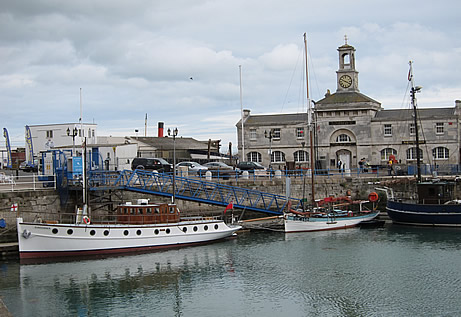 |
Getting up, the sun is shining and some of the troubles of yesterday are starting to recede to a memory layer deeper than short time memory. In other words, I feel fine, although there is quite a lot to be accomplished today. But first of all I walk into town, get some English pounds and have a proper English breakfast in a small workmen's cafe with my beloved International Herald Tribune for reading. After a stroll to buy a prepaid sim card for cheap local phone calls and above all affordable internet access I walk over to the Harbour Office in order to inquire about moving Betty to the inner harbour, because there is less swell, but most of all to save on the mooring fees, in case the weather forces me to stay for a few days. This does not seem to be a problem and at high tide I motor the boat through the lock and into a berth in the far cor- |
|
| |
ner of the Inner Harbour, where the Ramsgate Maritime Museum is situated. Regrettably the museum had to close its doors in 2010 due to financial pressures and it is unclear, when and if it will open again. But there are still a number of beautiful boats moored near the museum, Betty smack in the middle of them.
Today's remaining hours are spent between the boat and the marina facilities with its huge commercial washer and drier, getting the sea water out of the clothing in three long settings. By the evening I have everything clean and shipshape again and ready for a departure early tomorrow for the sail around the North Foreland and into the waters of the River Thames. |
|
| |
| |
|
Cruising into the Estuary |
|
|
| |
|
Wednesday, August 11th |
|
|
| |
This Thames Estuary journal has me round the North Foreland in my cruising smack Betty now, heading for a stretch of water, that has attracted so many invaders over the course of time, so many seafaring men before me, Romans, Vikings, Saxons, the Danes and the Dutch, some with good - but most of them with terrifying intentions. There were also smugglers and pirates, merchants and fishermen, and also, for a very short and recent period of time, yachtsmen - sailing only for their pleasure.
Now in August of 2010 I am such a sailor, steering my smack single handed along the coast of Kent for the Swale and the beginning of five exciting weeks of exploring and documenting these waters and the adjacent shores in pictures and in words.
Smacks, Bawleys and Thames Barges worked on the waters of the Estuary for centuries and brought commerce and trade and with it riches to the shores of the land. In addition, the farmers are working the land, the very rich soil of the marshes behind the sea walls, kept humid all year round by the closeness to the many rivers, streams and tidal creeks of Essex, Suffolk and Kent. |
|
| |
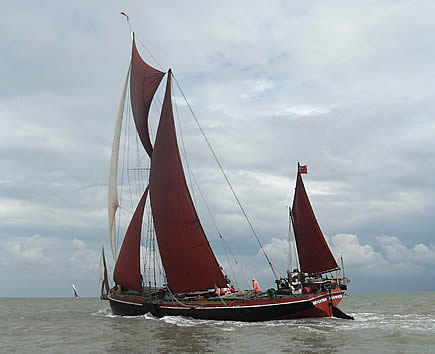 |
| |
|
|
After the experience of the Channel crossing, I am quite happy about this warm, sunny and almost windless day. Having chosen the inshore route through the Gore Channel, there would be very little to report, had I not been so very lucky: Reaching the entrance to the Swale late afternoon, just after passing the Whitstable Street to starboard, the most enticing scenery unfolds. Coming down from the main channel along the eastern shore of the Isle of Sheppey, a Thames Barge is sailing into Whitstable Bay with all her brown coloured canvas up and looking like a fine oil painting. Gazing into the afternoon sun behind her, I observe a few seals lying lazily on the uncovered sands in front of the lonely houses of Shell Ness.
The picture happening in front of my eyes is so beautiful and altogether so typical of the Thames Estuary, that I feel as if someone had welcomed me dearly to this proper beginning of my journey. Feeling quite overwhelmed I slow the boat down some and enjoy the moment in company of the barge and a few other yachts as we sail into the East Swale, some heading for Faversham Creek, some for the river, while I want to anchor at Harty Ferry and call it a day. |
|
"In the days of the Roman occupation the fortification of Reculver marked the entrance to an important waterway, a river which then meandered through the Kentish countryside into the Stour by Sandwich, making the north eastern segment of land, Thanet, a true island. (...) The small vessels of the day were able to enter Pegwell Bay and work their way into the Thames by this handy inland route, and thereby cut off the long haul round the turbulent North Foreland with its strong and unpredictable tides. But gradually this river silted up, always in need of more water than it actually had (...) For many centuries small craft had, in addition to this short cut, the benefit of a further inland route into the Thames, for by way of the East and West Swale they could cross the Medway and pass inside the Isle of Grain, coming out into London River by way of Yantlet Creek.
A well-manned Roman galley could make this passage on the young flood tide from the Regulbium settlement up to the ford at Londinium (near the present Blackfriars), and be back again with the next ebb the same day. With their astonishing organising ability and feats of engineering it is not surprising that the Romans, although not fundamentally a seafaring people, learnt the art of building strong seagoing ships early in their history, for the vast growth of their dominions throughout the Mediterranean and Europe called for well-organised sea routes."
[Maurice Griffiths „The First of the Tide“, 1979] |
> top
|
 |
| estuary |
thamesestu |
thamesestu |
thamesestu |
thamesestu |
thamesestu |
thamesestu |
thamesestu |
thamesestu |
thamesestu |
estuary |
thamesestu |
thamesestu |
thamesestu |
thamesestu |
thamesestu |
thamesestu |
thamesestu |
thamesestu |
thamesestu |
thamesestuary |
| |
|
Meeting People and Making Up My Mind |
|
|
| |
"In the unexpected event of strong winds from anywhere but westerly it is time to get the yacht under way, and shape course up behind the island to Harty Ferry, just beyond Faversham Creek, where her peace of mind will be restored in landlocked water.
Here she will lie in the East Swale, a channel which - although a mere backwater now - was once the main approach to London River. And not without reason was that route adopted. The ugly shoals of the outside channels, the hard, dangerous sandbanks, were not then buoyed and lighted and charted as now; there they lurked, hidden away under deceptive blue water save when the low tide uncovered them for a passing hour, or the storm seas declared their position by breaking heavily upon them. The Roman galley which piled up on the shoal outside in rough weather was lost, but the galley ashore in the Swale would only sit on the mud until the tide returned. (...)
Man is lord at present, but he was not the first occupier. "A monstrous elf was of old the Lord and Master of Earth," says the poet, and the biologists for once are on the side of literature. "Crocodilian reptiles" were here in Sheppey, and boa constrictors; birds with great beaks armed with teeth went straddling evilly over the land. Their remains have been found, but they (not altogether to one's sorrow) are gone.
Time wiped them all out. Gibbering and barbarous man followed ; then the stern and civilized Roman with his war galleys invaded the island. And again Time expunged them. In the ninth and tenth centuries the Norsemen often occupied Sheppey, and their "Dragons" wintered in the Swale. The great-limbed warriors wintered in the island; the only records of them now are the mounds which marked their burial-places."
[H. Alker Tripp „Shoalwater and Fairway“, 1924] |
|
|
Thursday, August 12th |
|
|
| |
This is the first time I use my little GRP dinghy to row ashore and in order to do so, I get out the oarlocks and sweeps and take care to have all the necessities for a longer walk in a watertight bag - that is: my purse, digital camera, phone, the 'Trib', a sweater and something to drink - to make sure, it stays dry should I capsize.
You see, the boat is truly an ugly little thing - the american idea of the perfect motorized fishing dinghy, that can be rowed in case the outboard won't start - and of very light build, which apart from the fact that I got it for free, is also its greatest advantage: it will nicely follow Betty without the tendency to smash into the counter with a following wave and when it does get at the topside, it will do no damage whatsoever. But the little weight makes it also quite unstable and unless I plant myself more or less in the middle, I will have the choice: to swim back to the boat or ashore. Today I am careful and after a pleasant walk along the beach it is time to get the anchor up and head for Faversham Creek, only about two miles away. Not at all certain, where I am going to stay for the night, I decide to turn off into Oare Creek instead of following the main water and right there at the yard near the entrance of the little creek, two men in overalls come out on a wooden landing and motion me to come near and make fast. Without a second thought I hand them my lines and oh how lucky, have found the ideal place for a smack in the vicinity: the Hollowshore Boatyard of shipwright Barry Tester. Barry is the owner of the big smack Alberta CK318 and has repaired and built many smacks to very high standards in his shed, where the spring tides fittingly flood the floor.
Allan, a friendly chap on a yacht nearby tells me of the Whitstable Barge and Smack Race the day after tomorrow and asks me to join. I do not say yes right away, but do accept a lift into Faversham by car. After a walk along the riverfront I reach Standard Quay, which is home to a number of Thames Barges and along which lie a couple of traditional working boats in various stages of repair. Here I hit upon the ' Anchor Inn', the classic sailors pub populated by a number of conspicuous looking patrons. Overhearing their talk of regatta racing, I join in and meet Frank C. and other smack owners of the region. Frank is a lively Irishman, who straight away talks me into taking part in the Whitstable regatta on the coming Saturday, brushing off any excuses I make, like having no crew. The very last objection I keep to myself, which is, I do not want to back track on my route by going to Whitstable.
Through the rainy evening I walk back to the boat, the light getting darker by the minute, but reach the yard just in time to find Betty deep down below in the mud beneath the landing. After searching for some time in the dark for something like a ladder I find an aluminium ladder just long enough to reach the deck. To celebrate this success I feel the need to have a beer in company and so I climb back up and join the few patrons of the ' Shipwright Arms' pub just behind the sea wall, before turning in. |
|
| |
| |
"In olden days the people of Faversham do not seem to have been very loyal to the Crown for they dug up the coffin of King Stephen for the sake of the lead, throwing the King's body into their creek; and probably they did the same for Queen Matilda. Also, when King James the Second was about to fly the country, they seized his vessel, as it lay in the East Swale. The story is related that the Faversham sailors observing a vessel of about 30 tons lying at Shellness to take in ballast, resolved to go and board her; accordingly they went in the evening with three smacks and about forty men, and in the cabin of it they seized three persons of quality. From them they took 300 guineas and two gold medals, and brought them all three to the shore beyond Ore - one of the three persons of quality was the King."
[H Lewis Jones „Swin, Swale and Spitway“, 1892] |
> top
|
| estuary |
thamesestu |
thamesestu |
thamesestu |
thamesestu |
thamesestu |
thamesestu |
thamesestu |
thamesestu |
thamesestu |
estuary |
thamesestu |
thamesestu |
thamesestu |
thamesestu |
thamesestu |
thamesestu |
thamesestu |
thamesestu |
thamesestu |
thamesestuary |
| |
|
Friday August 13th |
|
|
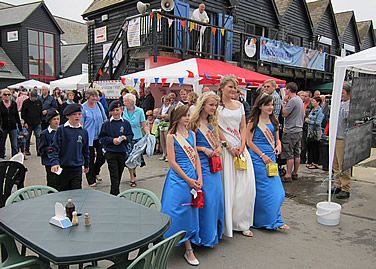
|
| |
In the morning I have made up my mind to sail to Whitstable for the race tomorrow after all. But first I have Barry Tester on board, who is happy to hear, that I will come to the regatta and has a thorough look at Betty. I point out to him the extensive work on the counter and the frames to port, the Dutch yard has carried out in the spring and he affirms the quality of the repairs wholeheartedly.
While we spend a considerable time inspecting difficult to access corners of the ship, torch in hand, more and more crews of the neighbouring smacks turn up and get their ships ready. With his girlfriend in tow Allan comes down to his yacht and is also very pleased to find me ready for Whitstable. |
|
| |
|
|
| |
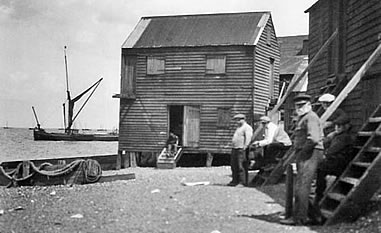 |
|
Up on the quay of Whitstable harbour there are preparations for the Harbour Festival tomorrow, which coincides with the Barge and Smack Race. One by one the smacks from Faversham now arrive, greetings are exchanged and when Frank and his Irish crew arrive, I join them to the nearest pub, where Frank seems to know everybody and introduces me to Richard and his young wife Elaine, somewhat Dutch in her free spirited good looking way, but born in South Africa. Also to a big, bald man - the owner of the local oyster and seafood restaurant "Royal Native Oyster Stores". Together we march over to his shop, which turns out to be right on the beach in the historic building of the Whitstable Oyster Company.
We get the full treat of a guided tour through the whole building - also looking at the oyster cellar, where the seawater can enter at high tide through a special canal - and a few fresh beers and oysters for testing. Then it is time for the next pub. My main goal for the next hours is to find someone to crew for the race tomorrow, not completely trusting Franks assurances, that he knew enough sailors for two boats. The next pub is tiny and at this hour very crowded. I drink a few rounds, flirt with Elaine and talk and talk and then suddenly everyone seems to have disappeared - they must have gone on. But by now I know everybody inside and also those out on the street in person.
Along the seafront there is another, but bigger pub right on the beach. I think I meet two or three of the others there, but neither Frank or Elaine are among them. At this stage I do not exactly know, who I have told about looking for crew for the race tomorrow and who not. Just by chance I get talking to a much younger bloke - his name is Justin - and get us and his girlfriend a round. Justin is really interested in Smacks and later even promises to be there early tomorrow morning. Stepping outside for a smoke I realize it has become dark outside and the sea is thundering up onto the beach in big Ocean waves... carrroumpff... carrroumpff... and I am very, very happy to be in Whitstable. |
|
| |
| |
"The Whitstable Oyster Company can trace its origins back to the 1400s; indeed, it is one of the oldest companies in Europe and has a long, rich history of farming the famous Royal Whitstable Native Oyster. But Whitstable oysters go even further back, almost two thousand years, to when the Romans discovered them and, regarding them as a delicacy, shipped them back live to Rome. More recently, and at the company’s peak in the 1850s, it was sending as many as 80 million oysters a year to Billingsgate fish market. By then the plentiful oyster had become the food of the poor.
A large fleet of Whitstable smacks was moored off the beach to dredge the oyster beds and the company flourished, but from the turn of the century a number of factors conspired against the industry – cold winters, the two World Wars, the great flood of 1953 and, not least, the introduction of the prawn cocktail.
In 1978 Barrie Green and his business partner John Knight took over the Whitstable Oyster Company. By this time it was practically defunct, with large debts and an unfashionable product. Oyster production had hit an all time low. Shortly afterwards the next generation, Richard and James Green, opened the fish restaurant in the old oyster stores and commenced production of the famous Whitstable Native.
Above the restaurant was then the town's unique 'Imperial Oyster Cinema' where you could get a drink from the bar, sit in one of the rows of padded armchairs to watch the movie of the moment amidst the unforgettable aroma of other peoples' fish dinners!
More than thirty years later, James and Barry have come a long way and can be proud of what they have achieved. They are still a family-run business and the world-renowned Native Oyster is once again a cherished food.." [from their website] |
|
|
> top
|
 |
| estuaryy |
thamesestu |
thamesestu |
thamesestu |
thamesestu |
thamesestu |
thamesestu |
thamesestu |
thamesestu |
thamesestu |
estuaryy |
thamesestu |
thamesestu |
thamesestu |
thamesestu |
thamesestu |
thamesestu |
thamesestu |
thamesestu |
thamesestu |
thamesestuaryy |
| |
|
Will I Get the Big Prize? |
|
|
| |
|
Saturday, August 14th |
|
|
| |
The day of the Whitstable Barge and Smack Race is here. Because of the tide we are to leave the harbour at eleven o'clock and the race starts at noon. Since it is still early in the day, I decide to go for an extended photo walk along Harbour Street - where the shopkeepers have just opened their doors and early shoppers fill the streets.
Once back I search out Frank for the promised crew member and big surprise, at the skipper meeting he tells me, Vic, a good friend of his wants to come along and then there is Justin, who promised last night to come to sail with us. Before they are to arrive, I clean up down below and prepare a few little goodies, like the fresh oysters I bought earlier at the harbour festival, which happens with stalls, selling second hand and new stuff, foods and the usual maritime fair. |
|
| |
|
|
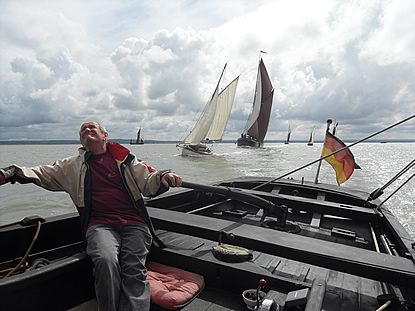
|
| |
Both crew members arrive in time and after introductions and the fresh oysters as a welcome snack, we throw off the lines and motor with the others out to the committee boat, where we set sail. The race is a lot of fun, but due to a few mishaps with the rig - especially with the topsail, which has not been hoisted after setting the mast in June and some of the lines run afoul - we cross the finish line third before last. In any case, the view of the other boats was stunning, Vic is an experienced and knowledgeable sailor of the local waters, who did most of the steering and everybody seems to have enjoyed themselves.
As if just for the price giving ceremony the sun breaks through the clouds and the ceremony becomes a real summer spectacle on two of the bigger boats - I applaud all the winners, not the least bit disappointed not to have won a prize. |
|
| |
|
|
Frank, who also had some problems and dropped out of the race wants to split and drive to his house to start preparations for his party this evening. He takes Vic and me along to the so called 'Irish Village', where in a beautiful house I meet his wife with a huge black, but friendly dog.
A lovely walk along the seafront brings me back to town and to the pub on the beach - the 'Neptune', where I had had a few beers too many last night. And who is sitting at one of the large steel tables out on the porch in the warm afternoon sun? Justin and his girlfriend with a group of young women. I squeeze in between them and am introduced to everybody around. A heated conversation ensues circling around subjects as diverse as sailing boats and living in a caravan. Until I realize it is getting quite late in the day, but I have not yet cleared up the boat after the race and also want to get to Franks party in time. A little sorrowful I say goodbye to Justin and all the lovely girls at the table and rush off to the harbour and Betty. |
|
| |
"The very name of Whitstable is almost one with oyster, by long association; and off Whitstable lie the famous oyster-beds. The beds are numbered, with oysters of graded maturity bedded out upon them; and the "fish" brought up in the dredges are classified A, B, C or D according to size. Those which are too juvenile even to be graded D are called "brood" or "spat", and are laid out in appropriate beds to grow up properly.
Up comes the dredge with its specimens of the sea-bottom - stones, seaweed, tin cans, star-fish ("five fingers"), crabs, whelks and what not, and all this rubbish is dumped down on deck of the "yawl." The Whitstable smack - though generally cutter-rigged - is still called a "yawl".
As the dredge was coming over the side, the experienced eye had spied the oysters, the real oysters, indistinguishable to ordinary eyes from the stones and empty oyster-shells innumerable. Over goes the rubbish into the water again, and the empty dredge follows it. Next time it comes up crammed with star-fish and never a sign of an oyster. "Them blinkin' old five-fingers, beggared we doan fetch up a few ton o' they, one o' these days, an' dump 'em ashore ...."
[H. Alker Tripp „Shoalwater & Fairway“, 1924] |
|
|
| |
|
|
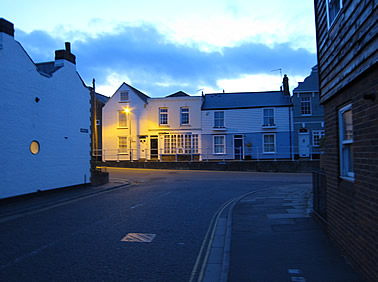 |
|
| |
Once there, everything is in the mess I left it in after the race, but there is a small party on the boat lying alongside - people of all ages are sitting on deck and in the cockpit, some with glasses of red wine in their hands. I get offered one myself by the skipper Richard, which I can not refuse and am introduced all around and asked to say a few words about Betty. I try to give my usual spiel about the former oyster smack, lovingly converted to a smack yacht in the 60's, all this while I tend to the loose ropes and sails lying all about. This, of course, is not so successful and only some time later, with a couple of visitors down below, I manage to finish my story. By now it is almost ten, and I have not even started the long walk to Franks house.
|
|
| |
|
|
| |
When I tell my visitors about it, they offer to give me a lift into town, which I gladly accept. With a few more minutes walk to Franks house, I arrive at the perfect moment, when everybody of the race is there and still more are milling in the garden and all over the house. Vic is there, I see Elaine and Richard with their son and Franks wife offers me something to eat, but for food I am a little late: the grill has gone cold and most of the platters are picked empty. But I do not care and am happy to find Frank in the house, who introduces me around and offers me a glass of whisky, which I gladly accept. After chatting with the lovely Elaine (and continuing to flirt with her), I run into Nick, who works on a Barge and has known my good friend Mike Emmett from Maldon times. We have a little smoke together (pretty good Turkish hash), after which I am drawn to the garden by the sound of live music to find Elaine sitting with the most enchanting group of people in a circle round an open fire. A young bloke is singing Irish lyrics in a light clear voice, after which everyone commences with the chorus - what a lovely night. When the early light of the morning appears over the tree tops, I say goodbye to Elaine and our host and start the trot along the seafront to the harbour and Betty, thinking all the time, what a wonderful beginning of my journey to the Thames Estuary this has turned out to be. |
|
> top
|
| estuaryy |
thamesestu |
thamesestu |
thamesestu |
thamesestu |
thamesestu |
thamesestu |
thamesestu |
thamesestu |
thamesestu |
estuaryy |
thamesestu |
thamesestu |
thamesestu |
thamesestu |
thamesestu |
thamesestu |
thamesestu |
thamesestu |
thamesestu |
thamesestuaryy |
| |
|
|
|
|
|
Good-humoured versus Out Of Humour |
|
|
|
|
|
|
| |
|
|
|
|
|
|
|
|
|
|
|
Sunday, August 15th |
|
|
 |
I sleep very little tonight - the wind has turned easterly and is blowing the breakers into Whitstable, which makes lying alongside uncomfortable indeed - ropes moan and then come tight with a bang, every-thing loose in the cupboards clatters noisily and I roll about on my cot. I wanted to leave on the early morning tide anyway, to not get stuck in Whitstable if the wind freshens and now I get up even earlier. Alan is up also and I wake the crew on Richards ship in order to discuss a way to get Betty out, she is stuck sandwich fashion between them. But with the wind from NE, it seems impossible and Richards crew has never manoeuvred the smack on their own, so I ask them to call Richard, insisting that they get him to Whitstable in a hurry. And indeed, here he is twenty minutes later and after a little while we all make it out of the harbour without a problem and motor together for the Swale on the early tide. |
|
| |
Finally alone again in the Swale after Alan and Richard have turned off for Faversham Creek, I motor only as far as the green No.1 buoy, where I drop the anchor next to Bonita, a lovely old yacht at her mooring, to wait for enough water in the Swale and in order to catch up on some sleep.
A couple of hours later on the ever turning river with two mouths - the one I entered from the East and the other to the Medway in the West - comes the only railway bridge to the Isle of Sheppey and a rather long wait for it to open. Now it is not far to Queenborough, where I pick up a mooring quite near to the hammerhead pontoon. Here the pull of the tide and the wind is again quite fresh and the boat seems to surf on the fast river waters. |
|
| |
In Whitstable I simply did not have the time to do some shopping. As a result the lockers are almost empty and hunger plus the need to have a fresh shower drive me ashore. I take the dinghy to the hammerhead and start looking for the Queenborough Yacht Club. In an old pub a live band is playing loud Rock'n Roll to a mostly drunk and rowdy audience in the court yard and to have a shower or to get something to eat is out of the question. Irritated I start walking into town, except I can not find a proper town, just a railway station with trains going to Sheerness every hour and certainly no restaurant, just a few dingy takeaways. When I am hungry I get seriously ill tempered and now my mood turns ugly. Everything I see seems in decay, the people are poor and the houses not kept up well. This is such a contrast to the rich and affluent Whitstable, I am definitely getting depressed.Only the glorious sunset on the way back
|
|
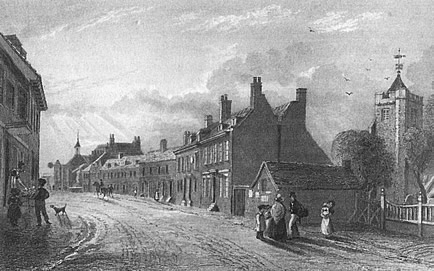 |
to Betty in the Dinghy does help my mood a little and after supper from whatever I can find in the lockers I am myself again. |
|
| |
| |
"In due time we ran into Queenborough and brought up; but did it badly, choosing a berth just ahead of a fishing smack, and not far enough ahead to be clear of her anchor. Although we felt a misgiving that all was not right, we proceeded to put on dry clothes, and as a special treat after the cold and wet, we went ashore and dined at a little inn, and there the passenger elected to sleep - wise man! Self and partner returned to the "Teal;" the tide had just turned, the boats were on the swing, the "Teal" betraying an improper affection for that horrid smack, and persistently kept sidling up alongside of it. "I say, Captain," says partner, "here's a pretty go, you have picked up a vile berth. I believe our chain is foul of theirs." "I know," replied I dolefully. Then to make things worse, that wicked "Teal" must needs try and swing round to the other side of the fishing boat, for all the world like a couple in a square dance, setting to partners. This was too dreadful, and her owners plunged into a heated argument as to which was her proper side. One thought the anchor was here, and the other thought it was there, and one was |
|
for shoving her round the bow of the vessel to clear her, while the other obstinately vowed that such an act would be fatal, by giving her chain a round turn round the other one's cable. After the discussion had con- tinued for more than an hour, to no purpose, in the bitter cold of a night in April, we both turned in, in an unhappy frame of mind, foreseeing trouble in the morning; but it did not turn out so very badly after all, for on weighing anchor we fished up the other one's chain, and were able to clear it without much difficulty, but we had had our lesson - never to let go anchor anywhere close ahead of another vessel, but rather, if room is scarce, to go just astern of one.
People usually anchor opposite the town, and very often there is not much room to spare, and it is not very nice to have to bring up in the middle of a lot of other craft, especially when the holding ground is at all doubtful, and they do say that the mud is so soft off Queenborough that an anchor is apt to drag through it."
[H Lewis Jones „Swin, Swale and Spitway“, 1892] |
|
| |
| |
|
Monday, August 16th |
|
|
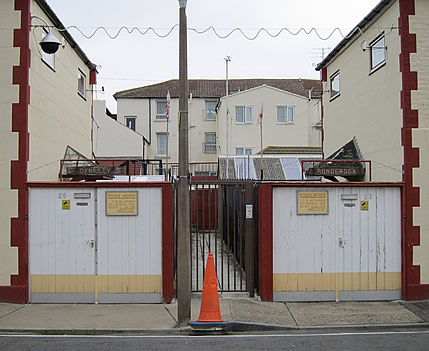 |
| |
A gray, chilly morning: The boat is swerving on her mooring line, the waves are choppy even in these sheltered waters, a NW wind is blowing a cold force 4 to 5. During breakfast I decide to row ashore and take the train to Sheerness on Sea in order to make my pilgrimage to the last residence in the life of Uwe Johnson. He, a brilliant, but almost forgotten German novelist, author of the grand novel "Jahrestage - Anniversaries", died poor and alone here on the Isle of Sheppey at the age of forty nine.
The train takes me on a ride along fields and open country, then through a dismal industrial landscape near the sea port to drop me off at a station in the middle of a huge parking lot, flanked by supermarkets and a MacDonalds. Walking past a desolate leisure centre I climb the huge concrete sea wall for a view of the gray and lonely beach, the green sea stretching as far as Essex on the other side of the river Thames. I walk on top of the sea wall towards the town, my mood thoroughly down. |
|
| |
|
|
|
| |
"Many objections can be raised against this island, infallibly they will be brought forward to me. It is not supposed to be at all beautiful there. This I admit un-expectedly compliant, because it is hard to deny that on both sides of the train fruit-tree plantations or rye fields in charming foliage verge disappear, as soon as the bridge over the Swale even comes into sight. The chalky, swampy meadows on the island are not at all the Garden of England (if it is at all possible for a tourist to keep up this empty phrase for much longer than from Dover to Canterbury). It is not beautiful there. Is that why we have come? It is true, even the Romans have not built villas there, expeditions to the isle are only assumed, not proven. It is a fact, Sheerness, about 14000 inhabitants, conspicuously becomes fringed by bathers who can only afford such stony beaches during the summer months or want to be content with a stroll and consumption on the stony sea wall promenade (most of them in wheel chairs: repeats an unfair voice). Sheerness does not even lie at the sea, as is tried to argue officially, only opposite it the north shore of the Thames ends, it is somewhat necessary to turn the head slightly to the right, if one wants to admit the open sea. (...)
Yes, the isle has tried it once with tourism and as a seaside resort, even with the fine arts, while Margate and Ramsgate are more elegantly equipped than this Insula Ovinium. In the summer day visitors come from London whose means are just about sufficient for this, also caravan owners looking for orderliness around their darlings. The life of the town, partly also of the island, is dominated by an unstructured hulk of iron-works, in which chopped cars are converted into steel for cars to be chopped up, thus by the dependency on this employer, also the not only union disputes with him. In return it is no dormitory town, like the spread out settlements in the stockbrokers' belt of Surrey with their charming prosperity, but an ugly, living commun-ity. There on the northern shore of the Thames Estuary, where it is already wide open, almost without a shore opposite, we have a terraced house from around 1912, which would be called a brownstone by you, like ours, there is a factory in the cellar, and above the yeild is consumed. Yield, I mean. Not exactly an accidental mistake."
[Uwe Johnson „Island Stories“, 1995] |
|
The low hanging mass of gray clouds with a light drizzle falling now and then does not improve the look of an empty seaside resort, which must have seen better days in the past.
The houses on Marine Parade, where Uwe Johnson lived hidden behind the huge sea wall, look forlorn with unkempt front yards. Asking a few neighbours to try and find the exact house is in vain, nobody remembers his name and - as to be expected - there is no plaque to be seen anywhere. But I do find the local pub he frequented regularly (mentioned in the collection of short stories about the Isle of Sheppey - 'Inselgeschichten'), which at this early hour is of course closed. Since I do not intend to look for his grave - I do not even know, if he is buried here - I sit down near the sailing club in the shelter of the sea wall and have a smoke. Then and there a thought comes my way: to write a journal of the events on this trip in addition to Betty's log book, detailing the experiences and private thoughts that do not necessarily have a place in the logbook. I start with what you read here in the corner of a little cafe on High Street, having a couple of days to catch up on by now.
Back on the boat by noon, with stocks filled up and everything shipshape, the mooring line is dropped and I set off under engine and staysail alone for the Medway, planning to motor sail up the river as far as Rochester in order to look for a good berth, convenient for trips ashore and perhaps London town.
There are hundreds of berths already taken up by boats below Chatham, when I slowly wound my way round the many bends of the old river. By now the sky has cleared up with the sun shining warmly from a blue sky onto the many sites along the shores soaked in centuries of naval and military history. |
|
| |
Past Chatham round the last two bends to the old bridge crossing the Medway there are no berths for yachts to be found so I turn around and head back for Chatham Reach, when I suddenly spot a vacant berth on a pontoon, that could just be long enough for Betty. And really, I just about manage to nudge her into this spot and kill the engine, but it sure is a close fit. Perceiving a couple who enjoy the afternoon sun on their yacht, I ask them about the practicalities of a two night stay there and am told, that I need a key to open the heavy gate up on the landing. After calling a friend they manage to get the phone num-ber of the harbour master, who lets me know that this is not a public landing, but after some delibera-tion, promises to come down later in the evening in order to arrange something and bring me the key. Very satisfied with the way today turned out for the best, I bring order into the ship and cook myself a good sized meal. Later I hear from Tony, the harbour master, I made fast at the Thunderbolt Pier, which is part of the Historic Dock-yard of Chatham and that I can stay till Friday, if I feel inclined to do so. I pay the fees for two nights, get the key and instructions and |
|
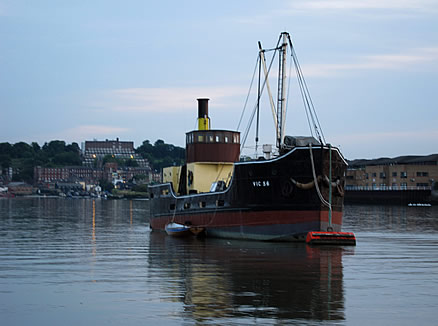 |
| |
after admiring the boat - underscored by sharing a bottle of good wine, Tony leaves me for a good night in what feels like 'Abraham's lap'. |
|
> top
|
| estuaryy |
thamesestu |
thamesestu |
thamesestu |
thamesestu |
thamesestu |
thamesestu |
thamesestu |
thamesestu |
thamesestu |
estuaryy |
thamesestu |
thamesestu |
thamesestu |
thamesestu |
thamesestu |
thamesestu |
thamesestu |
thamesestu |
thamesestu |
thamesestuaryy |
| |
|
|
|
|
|
Unexpectedly Thinking of the USA |
|
|
|
|
|
|
| |
|
|
|
|
|
Tuesday, August 17th |
|
|
|
|
|
|
| |
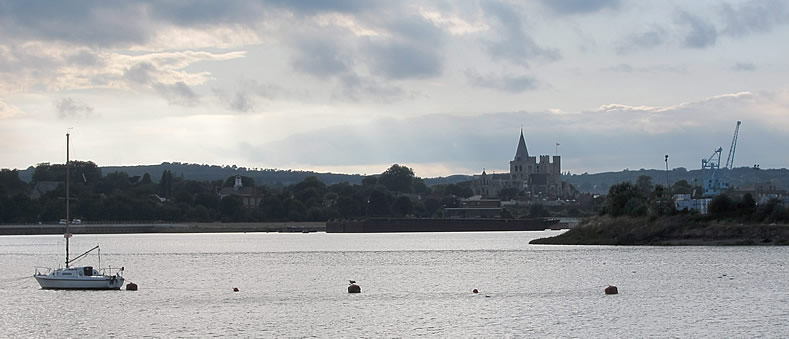 |
|
| |
"A year or two since, three of us sailed up to Chatham, to assist at the opening cruise of the Medway Yacht Club, and also at the opening dinner to follow, finding our way back eventually to the Sun Pier at eleven p.m. After being carefully deposited on board the "Teal" from a shore boat, for it hardly seemed the time to trust one's fortunes in a seven-foot Berthon, (...) at about five in the morning, an enterprising young ruffian thought the occasion a good one for coming alongside to prospect for moveables, little reckoning that as he touched the little vessel's sides there would emerge, jack-in-the-boxlike, a half-dressed and dangerous looking figure from the fore hatch and another from aft, with a truculence of aspect heightened by a pair of gold spectacles; and that both, in well drilled chorus, and in accents bland, would demand an explanation of the un-expected visit. The double-barrelled apparition proved too much for our young friend; his jaw dropped, he hastily withdrew, murmuring by way of apology for his intrusion, "I say, d'yer stay out all night in that 'ere?"
[H Lewis Jones „Swin, Swale and Spitway“, 1892] |
|
Before last night I decided for a harbour day today - there is Chatham to explore and historical Rochester is close by. To my astonishment I have had these fleeting associations and even clear memories of my stays in the USA to an extent I have not known for many years, when arriving at Chatham last night.
In particular it is the industrial landscape round and about the town of Fall River in the south of Massachusetts, where I spent some time in 1975, I am thinking of when I find my way through a maze of the large buildings of the Navy Yard barracks - now part of the Historic Dockyard - to the entrance, flanked by sentries in historic costumes and out, across a wide arterial road (a 'four lane blacktop' but for the left-hand traffic and European cars of course) to enter a residential neighbourhood, that indeed looks, feels and even smells like somewhere on the East Coast of America. |
|
| |
It does take me quite a while to realize that this neighbourhood is a large housing estate for military personnel: run down tenement houses for the renting foot soldiers and also smart mansions for the commanding few, the officers, built in the 19th century probably for the Navy brass. A pub on the 'town square' carries the painting of a huge battleship on one of its walls. Then I discover the sign posts of a historic walk and follow them up the hill in search of a commanding view, when suddenly I realize, that I am followed by a gray pickup truck, slowly driving in a little distance at the speed of my walking. Annoyed I walk over after some time and indeed, there is a man in military fatigue sitting next to the driver. In response to my questioning the driver pretends not to have followed me, but as soon as I turn into a dead end with more barracks further up, they drive up to me and the driver tells me to turn back: "this is a military exclusion area, you should not be here!" To the officer I explain, that I am simply following the historic walk and could not see any signs forbidding the public. But to no avail, he does not address my directly and the driver makes it quite clear, they do not want to discuss. Keeping their ridiculous distance they follow me all the way down the hill at slow speed only to drive off when we reach the main street and another high wall and a gate with armed guard posts. My curiosity really awakened by now I follow the wall with NATO-wire fence on top along the arterial road towards Chatham centre, when I get to a wide open space with parking lots and a visitors centre surrounded on one side by steep chalk cliffs. |
 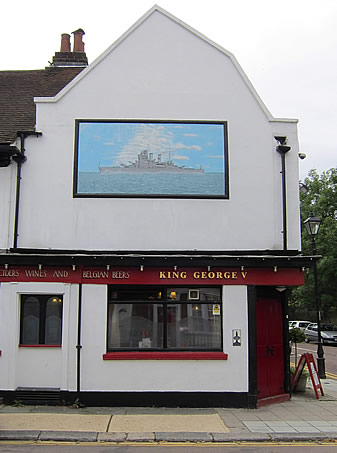 |
| |
This, it turns out, is the entrance to the historic Fort Amherst - also a tourist attraction, that used to protect the Naval base against Napoleon from the Kentish mainland for centuries until the end of WW II. If you are now as puzzled, as I was then, you should not worry too much. All this is military thinking and planning which is not easily comprehended by us common citizens (or travelers), but two things are certain: first, behind the walls of those barracks very secret military operations are still taking place today and two, all this confirmed my gut feeling of parallels to something that reminded me strongly of the military obsessions in the USA. |
|
|
To Sail Up the River Thames or Not To |
|
| |
"In Kipling's lines the Dutch invasion has been woven into our culture:
 No king will heed our warnings, No king will heed our warnings,
 No court will pay our claims - No court will pay our claims -
 Our king and court for their disport Our king and court for their disport
 Do seil the very Thames! Do seil the very Thames!
 For now De Ruyter's topsails, For now De Ruyter's topsails,
 Off naked Chatham show, Off naked Chatham show,
 We dare not meet him with our fleet - We dare not meet him with our fleet -
 And this the Dutchmen know. And this the Dutchmen know.
Off Gillingham we pass the site of the first British attempt to stop the Dutch reaching Chatham, a chain was stretched across the river,
shackled to Hoo Island and then tightened up with a Spanish windlass. It was a pathetic defence; Van Ghent's leading ship simply rode his stern up over it until the weight of his ship as she drove further on snapped the cable as though it were made of chicken wire. A northerly breeze starts to tug at the headsails as we near the end of Gillingham Reach."
[Dick Durham „On and Offshore“, 1989] |
|
Walking along the main road to Rochester, I pass derelict yards and strange little shops run by Lithuanians, everything looks run down and very poor in this part of Chatham. All this changes after crossing the old bridge across the Medway, I saw from the boat yesterday. Now there are groups of young Japanese and French tourists in the streets, coffee houses and second hand bookstores in beau-tiful old houses (the most famous is Charles Dickens Chalet) - I am in the historic City of Rochester. But I do not stay long: in doubt whether I should take Betty up the River Thames to Gravesend, I catch the bus to this old river port on the spur of a moment and some time later step off in the centre of Graves-end. Here I am interested in the possibilities of a good berth at the Embankment Marina, the only viable port for yachts on this stretch of the Thames. There are a number of nice looking barges moored in |
|
| |
the basin, giving the place an almost Dutch appear-ance, but the access to the marina is somewhat restricted: to enter or exit through the old, manually operated lock is only possible at or near high tide and an ugly modern building block towers over the part of the basin, where a few yachts have their berths.
Having now almost decided to skip Gravesend on this journey, I am nevertheless glad to have made my way here by coach and do some serious sightseeing including the ferry landing to Tilbury (where I almost step on board to cross the river for the famous Tilbury Fort), the Royal Pier and up the broad Hamer Street to the classic victorian Jubilee Clock Tower, erected to commemorate Queen Victoria's golden jubilee in 1887. I definitely enjoy this attractive little town and decide to come back some time later, but really tired by now, find my way to the railway station and take the next train back to Chatham. There I had planned to shop for groceries, but it being just after six o'clock all the shops are closed I make my way back to the boat and eat hamburgers and hash browns for dinner before turning in early. |
|
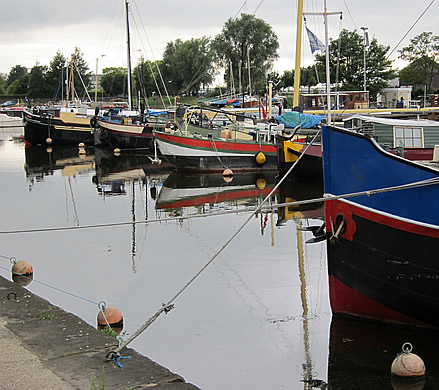 |
> top
|
| estuaryy |
thamesestu |
thamesestu |
thamesestu |
thamesestu |
thamesestu |
thamesestu |
thamesestu |
thamesestu |
thamesestu |
estuaryy |
thamesestu |
thamesestu |
thamesestu |
thamesestu |
thamesestu |
thamesestu |
thamesestu |
thamesestu |
thamesestu |
thamesestuaryy |
| |
|
|
|
|
|
Wednesday, August 18th |
|
|
|
|
|
|
| |
The research for titles of cruising literature, of the Thames Estuary in particular, is the motto for today. The first place to visit in order to peruse this endeavour is of course Greenwich, which I will visit by train and on foot - having turned in early last night it is an early rise today, leaving Chatham station on a commuter train in the early morning rush hour. How can I best describe the scene: this mixture of ages - schoolboy in uniform and city accountant in office gray, local housewife in faded jeans with colourful patches and smart looking, black student with the obligatory IPod plugs in her ears? The train picks up this multitude at every station, Rochester... Gravesend... Greenhithe and Woolwich until even the aisles are filled with passengers, swaying in the many curves along the river, and I am glad that I was able to secure a seat near the window, watching a denser and denser suburban housing flying by, the fields getting fewer and fewer and the industrial landscape taking over.. ... London the metropolis is beckoning. |
|
| |
"It may be worth mentioning that in the lower part of Cockham Wood Reach there is a mud flat over against the village of Hoo. It begins to run out from the shore near a curious sort of patch of red brick wall, which is, as a matter of fact, the remains of a fort built in Queen Elizabeth's time, and once proudly mounting twenty-three guns, for the benefit of the adventurous Dutchmen, who were much too fond of expeditions up the Medway, which they enlivened by cannonading Sheerness, burning the fleet at Chatham, and other desperate behaviour. De Ruyter, for instance, came up in 1667, and burnt a fleet at Gillingham and also went on to Upnor, where, perhaps, Upnor Castle may have stopped him, but for details the reader may consult Mr. Pepys' diary. I once made a visit to the old fort in Cockham Wood Reach, to see if it really was anything more than a ruined brick-kiln, as had been stoutly maintained by a Rochester friend of mine, and although there were no doubloons, nor, pieces of eight lying about loose on the ground, yet there were other evidences of high civilisation in the shape of ancient broken bottles, of coarse glass and broad squat shape, such as the buccaneers of those days might have used to carry their rhummi succus in. "Rhummi succus" is the "orsepital name" for rum, at any rate among the initiated."
[H Lewis Jones „Swin, Swale and Spitway“, 1892] |
|
In Greenwich I get off the train and walk - street map in hand - to my first address of the day: a second hand bookshop, specializing in maritime books, only to find it has gone out of business, but also to realize, that I know the neighbourhood from an earlier visit. And just around the corner is the place I am remembering, which was closed then, but today I meet the proprietor of the shop in person and he fits this neighbourhood perfectly, a distinguished looking Sixty something, a gentleman, a little bored, but when he hears my queries is really quite helpful. Then I walk over to Greenwich Maritime Museum, where I want to visit the splendid library, on the way passing another bookstore on my list: there is now a coffee shop. In the library of the museum I first have to become a member (for free for one year) and then with the help of the friendly staff start to make a handwritten list of the treasures of books the library holds in its catalogue. Unfortunately, I am told that a large new donation of books on cruising have not yet been catalogued and are kept in an annex of the library, not accessible to visitors at the moment. |
|
| |
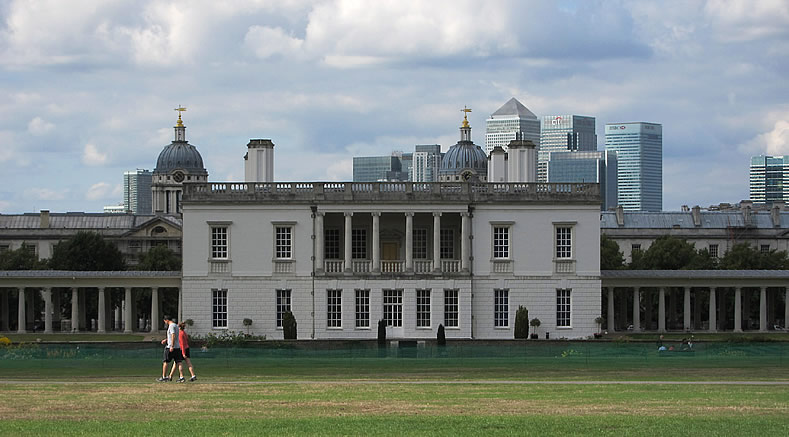 |
|
| |
Even so I manage to look at many books and write down a number of titles for future reference. Some of the older books, that have long been out of print, can nevertheless be found at Amazon or my favourite AbeBooks.com and bought for less than a fortune. After a couple of hours I am tired of the books and walking briskly through the museum, which I have visited previously and which is certainly worth a visit, I head outside into the sunshine and tour some of the Royal Naval College on my way to the river.
When down on the pier I notice the high speed catamaran to London is about to leave and on the spur of the moment I decide to get on and take the fast ride up the River Thames all the way to the Charing Cross Pier. Walking up Charing Cross Road to Foyles Bookshop, I am seriously disappointed, because the many second-hand bookshops, that used to line the eastern side of the street are now gone except two, which are of no help to me. To catch my train from Victoria Station after I had a smoke in Soho Square I cross Soho diagonally to Regents Street and then St. James Park, noticing, how young, multicultural and good looking the other pedestrians are and of course the many tourists, here in the metropolis compared to the people of Chatham for example. |
|
| |
|
|
|
Mud Crawling Across the Great River Thames |
|
|
|
|
| |
The fast train to Rochester and then a quick walk bring me back to Chatham and the boat, but only after I did my shopping - today with enough time before the stores close at six. After a brief consider-ation I leave the key and my £20 harbour dues in the letter box, start the engine, cast off the lines and manoeuvre the boat off the pontoon. And then it happens: the tide and a little breeze push Betty upstream and before I have made enough distance to the quay, she is pressed against the yacht behind. I have a number of fenders out and almost manage to push her off, but the boats touch briefly, the paintwork of the yacht gets scratched... an instant later she is off and I am at the helm and manage to reach free water. As often in cases like this, I do not know how to best proceed. I should turn around, make fast again and try to get in touch with the owner. But then again, as the situation is, this manoeuvre can lead to even greater damage and the scratch is probably very small... Today I keep moving on and enjoy the warmth of the late afternoon, motoring down river along the many boats lying peacefully at their moorings on the Medway. |
  |
| |
About an hour later, trusting the 'Geonav' navigation and my depth sounder, I sail a short cut over the Yantlet Spit and later the Ham Ooze to Sharfleet Creek and then Stangate Creek, which cuts the time by maybe half an hour and is not really necessary in this gorgeous sunset but risk-free fun at now almost high water. Very slowly and carefully I make my way up Twinney Creek with the last rays of the sun and into the eastern twilight, getting dark fast. With a foot of water left under the keel I stop the engine and let go of the anchor, which touches the ground in seconds and pulling back under engine I let the anchor bite, switch it off and now every-thing is peacefully quiet. I can make out the twinkling lights of a little landing towards the east, but here I am completely alone with my thoughts and the ship. |
|
| |
|
|
|
|
|
|
|
|
|
|
|
|
|
|
|
|
|
> top
|
| |
|
|
|
|
|
|
|
|
|
|
|
|
|
|
|
|
|
|
|
|
If you want to be in the know about your user statistic and those of the other users of this site, click on this link to the webanalysis, log in under the user name "I_m" and the password "informed" and you'll be surprised.
top | home | logbook | photos | sources | maps | links
© Jan Holthusen 2012 | Webmaster
|

